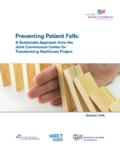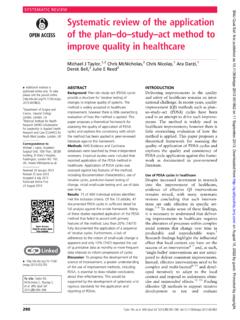Transcription of © 2018 The Council for Six Sigma Certification. All rights ...
1 2018 The Council for Six Sigma Certification. All rights reserved. Harmony Living, LLC, 412 N. Main St, Suite 100, Buffalo, WY 82834 June 2018 Edition Disclaimer: The information provided within this eBook is for general informational purposes only. While we try to keep the information up-to-date and correct, there are no representations or warranties, express or implied, about the completeness, accuracy, reliability, suitability or availability with respect to the information, products, services, or related graphics contained in this eBook for any purpose. Any use of this information is at your own risk.
2 The author does not assume and hereby disclaims any liability to any party for any loss, damage, or disruption caused by errors or omissions, whether such errors or omissions result from accident, negligence, or any other cause. This is a free eBook. You are free to give it away (in unmodified form) to whomever you wish. Page | 2 2018 The Council for Six Sigma Certification. All rights reserved. Using the most recent edition in your workplace? Because we continually attempt to keep our Handbook up to date with the latest industry developments, be sure to check our website often for the most recent edition at Page | 3 2018 The Council for Six Sigma Certification.
3 All rights reserved. Table of Contents UNIT 1: INTRODUCTION TO SIX Sigma .. 5 CHAPTER 1: WHAT IS SIX Sigma ? .. 5 Data Driven Processes and Decisions .. 5 Defining 6 .. 6 Common Six Sigma Principles .. 9 Challenges of Six Sigma .. 12 CHAPTER 2: SIX Sigma HISTORY AND APPLICATION .. 14 The Development of Statistical Process Control .. 14 Continuous Process Improvement: Toyota and Lean .. 15 Motorola s Focus on Defects .. 16 ABB, Allied Signal, and General Electric .. 17 Continued Growth of Six 18 Applying Six Sigma Knowledge .. 19 CHAPTER 3: OTHER PROCESS IMPROVEMENT AND QUALITY METHODS.
4 22 Other Formal Quality or Process Improvement Programs .. 22 When to Use Six Sigma .. 28 Page | 4 2018 The Council for Six Sigma Certification. All rights reserved. Unit 1: Introduction to Six Sigma Chapter 1: What is Six Sigma ? Six Sigma , or 6 , is both a methodology for process improvement and a statistical concept that seeks to define the variation inherent in any process. The overarching premise of Six Sigma is that variation in a process leads to opportunities for error; opportunities for error then lead to risks for product defects. Product defects whether in a tangible process or a service lead to poor customer satisfaction.
5 By working to reduce variation and opportunities for error, the Six Sigma method ultimately reduces process costs and increases customer satisfaction. Data Driven Processes and Decisions In applying Six Sigma , organizations, teams, and project managers seek to implement strategies that are based on measurement and metrics. Historically, many business leaders made decisions based on intuition or experience. Despite some common beliefs in various industries, Six Sigma doesn t remove the need for experienced leadership, and it doesn t negate the importance of intuition in any process. Instead, Six Sigma works alongside other skills, experience, and knowledge to provide a mathematical and statistical foundation for decision making.
6 Experience might say a process isn t working; statistics prove that to be true. Intuition might guide a project manager to believe a certain change could improve output; Six Sigma tools help organizations validate those assumptions. Decision Making Without Six Sigma Without proper measurement and analysis, decision making processes in an organization might proceed as follows: Someone with clout in the organization has a good idea or takes interest in someone else s idea. Based on past experience or knowledge, decision makers within an organization believe the idea will be successful.
7 The idea is implemented; sometimes it is implemented in beta mode so expenses and risks are minimized. The success of the idea is weighed after implementation; problems are addressed after they impact products or processes in some way in the present or the future. What is beta testing? Beta testing is the act of implementing a new idea, system, or product with a select group of people or processes in as controlled an environment as possible. After beta testers identify potential problems and those problems are corrected, the idea, system, or product can be rolled out to the entire population of customers, employees, or processes.
8 The purpose of beta testing is to reduce the risks and costs inherent in launching an unproven product or system to a widespread audience. Page | 5 2018 The Council for Six Sigma Certification. All rights reserved. Beta testing is sometimes used in a Six Sigma approach, but the idea or change in question goes through rigorous analysis and data testing first. The disadvantage of launching ideas into beta or to an entire population--without going through a Six Sigma methodology is that organizations can experience unintended consequences from changes, spend money on ideas that don t end up working out as planned, and impact customer perceptions through trial-and-error periods rife with opportunities for error.
9 In many cases, organizations that don t rely on data make improvements without first understanding the true gain or loss associated with the change. Some improvements may appear to work on the surface without actually impacting customer satisfaction or profit in a positive way. Decision Making With Six Sigma The Six Sigma method lets organizations identify problems, validate assumptions, brainstorm solutions, and plan for implementation to avoid unintended consequences. By applying tools such as statistical analysis and process mapping to problems and solutions, teams can visualize and predict outcomes with a high-level of accuracy, letting leadership make decisions with less financial risk.
10 Six Sigma methods don t offer a crystal ball for organizations, though. Even with expert use of the tools described in this book, problems can arise for teams as they implement and maintain solutions. That s why Six Sigma also provides for control methods: once teams implement changes, they can control processes for a fraction of the cost of traditional quality methods by continuing the use of Six Sigma tools and statistics. Defining 6 Six Sigma as a methodology for process improvement involves a vast library of tools and knowledge, which will be covered throughout this book. In this section, we ll begin to define the statistical concept represented by 6.







